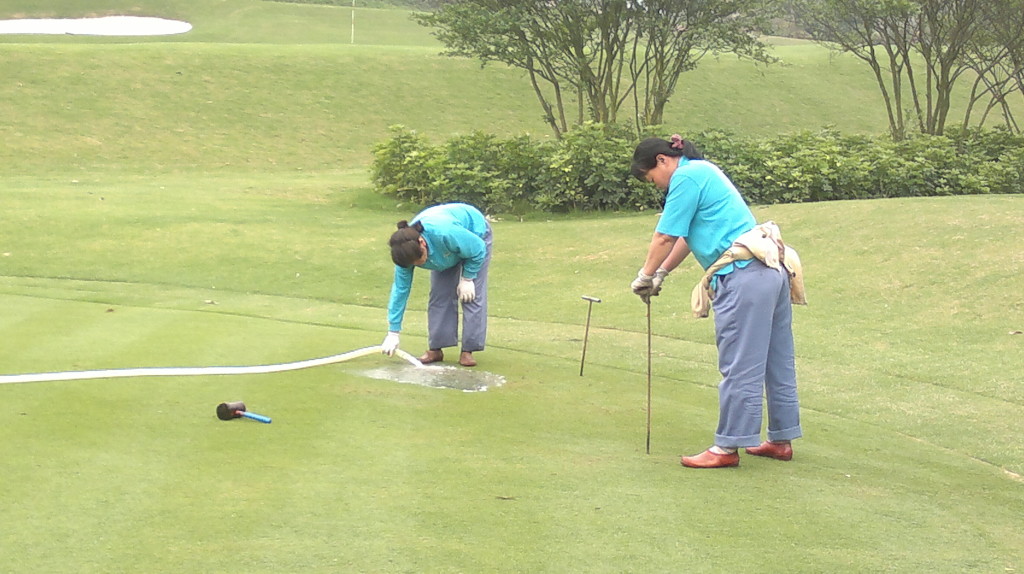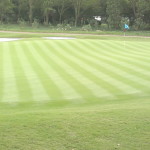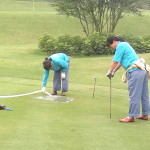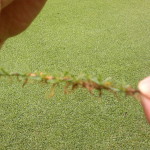My recent post about grass plant physiology sparked a few questions by email about the term “Cool Season Grass”, a question only likely to crop up in the UK once every decade or so when we eventually get some hot summer weather! A brief summary of the differences between warm and cool season grasses below:
Cool Season Grasses
Cool Season turf grasses are best adapted to growing during the cool and moist periods of the year and do most of their growing in the UK during late spring/early summer. In a decent summer you will see growth rate tail off in mid summer and this will usually be followed by another growth spurt in late summer/early autumn. The cool season grasses are best adapted to grow well in temperatures ranging from 150 to 240 C. This group includes all of the usual turf forming suspects that are common in the UK such as Agrostis (Bent grasses), Poa (meadow grasses), Festuca (fescues) and Lolium (rye grasses).
Warm Season Grasses
The warm season turf grasses are best adapted to growth in the temperature range of 270 to 350 C, they grow best during the warmest part of the year and can go dormant and even suffer injury during cold weather. Dormancy typically kicks in at around 10 degrees when the entire turf will take on a yellow colour. Examples of the warm season grasses that some of our American, Australian and South African readers will be familiar with are Axonopus (Carpet grass), Cynodon (Bermuda grass), Paspalum (Bahia grass and Seashore paspallum) and Zoysia (Zoysia grass).
Photosynthesis
The main difference between the two groups is the way in which they photosynthesise or produce food for themselves. The first product of photosynthesis in cool season grasses is a 3 Carbon sugar molecule so these grasses are commonly referred to as C3 grasses. In warm season grasses the first product of photosynthesis is a 4 Carbon sugar molecule, so they are referred to as C4 grasses. C4 photosynthesis is thought to be an evolutionary adaptation that has allowed grasses to thrive in very warm and tropical environments.
Transition Zone
However, there is a band of territories around the world where the annual climatic conditions are not suitable for one type of turfgrass all year round, especially if you want to produce a nice green turf. It is too hot in summer for cool season grasses to stay healthy and too cold in winter for the warm season grasses. This is called the transition zone and turf managers in these areas sometimes use over seeding methods to produce an actively growing, green stand of turf all year round. This typically means that they will over sow their warm season turf with rye grass seed in the autumn and the turf will transition from warm to cool season grass in the winter. When spring comes they will put undue stress on the cool season grass in order to make room for the recovering warm season species to take over again.
I was recently teaching golf industry professionals in Southern China, which is in this transition zone and the golf club where I was staying has gone to extreme lengths to make sure its customers are kept happy all year round. They have two greens at every hole, one with creeping bentgrass for the winter period and one with seashore paspallum for the summer period.
I will write a bit more on photosynthesis soon. Meantime if you have any questions just drop me a line as usual or leave a comment on this post.





This is interesting. Would you say the South East of England is in the transition zone (Kent/Sussex)?
I have made some efforts to improve my lawns this year with core aeration, scarification, top dressing and over-seeding. While doing this I discovered that one of my lawns (the largest and furthest from house) is what I believe to be Bermuda grass. I’m not sure whether this is intentional on the part of the previous homeowner or whether it has just crept in and established itself. It does explain why that particular lawn looked the best during the peak of summer without any irrigation and seems to be able to heal itself, but, may also explain why it looks like it’s struggling for a lot of the year, does not seem to want to grow taller like the other grasses, has serious weed invasions over winter/spring and problems with moss/thatch build up particularly in more shady and damp areas.
I have scalped and over-seeded with a perennial ryegrass/creeping fescue mix this autumn with the hope of improving the overall look for next spring.
If the South East is in the transition zone, would Zoysia Japonica perform better than Bermuda grass? Reports for the states say this is a warm season grass that performs better than others over winter with a longer growing season, self healing/creeping action, ability to choke out weeds and it stays greener when dormant over winter when compared to other warm season grasses. I don’t see much discussion at all regards using this in the warmer parts of the UK. Seed seems expensive and difficult to source with supplies coming from France or the US.
Would love to hear your opinion on this.
Hi Justin
Although climate change has caused some difficult weather patterns for us, I’d say that the UK is still very firmly in the Cool Season zone and that C4 grasses aren’t a viable option here just yet.
Regards
John
Thanks.
Several years later I’ve decided that what I originally thought might have been bermuda grass is some type of creeping weed grass, perhaps Poa trivialis. While it appears to be similar to bermuda it does not go brown/dormant in the winter so certainly is not. I’ve also found over the past few hot summers that it does not do as well as my ryegrass/fescue lawns even when watered; I’ve read that some weed grasses have very shallow roots which might explain that. The plan is now to wait until late summer, blitz the area with a non-selective weed killer and reseed with a good quality cool season turf grass – as per my other lawns.
With respect to Zoysia I have been growing some plugs from seed and will plant them out in the summer as an experiment to see what happens, whether they survive/establish themselves over the coming years or die off.
It’s a shame that our climate isn’t suited to warm season grasses. They seem more durable and I’d much rahter have a lawn that stays green and lush June-September when we’re enjoying the garden and goes dormant over the Autumn/Winter/Spring than one that’s green through the cooler wetter months and goes brown when the summer hits. Regular irrigation is difficult for your average homeowner with water meters, hosepipe bans etc. Even a significant amount of collected rainwater in IBC containers doesn’t go far when watering 300m2 of lawn.
Fingers crossed someday a ‘transition zone’ turf grass will be discovered that gives us the best of both worlds.